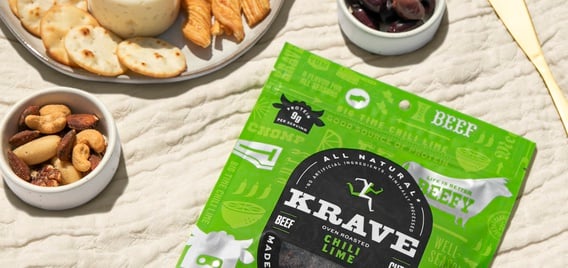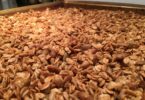When Hershey made the decision to divest its premium jerky offering Krave two years ago, the first call executives made was to an entrepreneur intimately familiar with the brand: its founder.
It took only 60 days for Jon Sebastiani to buy back Krave, paying what he described as a “substantial discount,” just five years after selling it to the confectionary giant for nearly a quarter of a billion dollars. But the purchase was far from a sentimental one; instead, it was about rehabilitating the once-thriving jerky brand.
Krave had lost market share, sales were slipping and its quality had deteriorated. The brand and the retail landscape had shifted considerably since Sebastiani last owned it.
“Our product needed a lot of replumbing and rewiring … to get it back to a spot where a customer would be like, ‘Oh, okay, now I remember what Krave used to be like,’ ” said Sebastiani, who now runs Sonoma Brands Capital, a private equity investor focusing predominantly on food. “This was not an emotional buy. This was not some form of nostalgia. It was a fundamental strategic decision that we felt that there [would be] a meaningful return on our investment.”
Krave was among the brands that turned jerky, once viewed as a cheap junk food option, into a trendy snack with consumers hungry for protein and lower-carbohydrate choices that were portable. Hershey, which was looking to grow its snacking portfolio, viewed the brand as a way to enter the emerging premium meat-snack market.
But Krave under the stewardship of Hershey, best known for its expertise in sweets like its namesake bar, Reese’s and Kisses, had lost its coveted tenderness and was “like chewing a piece of cardboard,” Sebastiani recalled.
Many retailers simply stopped carrying the brand, and sales plummeted from about $70 million when Sebastiani sold Krave to $20 million when he repurchased it. Once the trendsetter in the premium jerky space, Krave slid from being the top-selling brand, struggling as consumers drifted toward mainstream options where growth was more robust and a proliferation of competitors in the premium segment squeezed profit margins.
Hershey CEO Michele Buck was outspoken before the divestiture of Krave about challenges facing the brand. It requires “a different go-to-market model that we believe is better supported by other owners,” she said at the time.
From a sprint to a marathon
A growing number of private equity groups, companies and other investors like Sebastiani are purchasing brands being divested by large CPGs — often with the hope of turning around a once-thriving offering or nurturing a product that for years languished in the shadows of bigger or faster-growing items.
As companies tweak and in some cases overhaul their businesses, they are offloading assets for a variety of reasons. Executives may want to prioritize their most promising assets while divesting those that no longer fit with the other brands in their portfolio or deviate from their long-term strategy.
A brand may have failed to deliver the expected growth or was more difficult to integrate into the existing business than originally thought. A difference in strategy also may have formed between the CPG and the leadership at the acquired company that was beyond repair.
Optional Caption
Courtesy of Krave
“The culture of many of the CPGs is they’re managing a portfolio of 10 brands, sometimes 20 brands. So to get that level of dedication from a CEO at a very high level, it’s extraordinarily difficult,” said Brian Choi, CEO of The Food Institute, a food industry media and market research company.
Unlike his first time nurturing Krave when sales were tripling annually, the “sprint” as Sebastiani calls it, has been replaced by a marathon where “the business is being built one brick at a time, one account at a time and the improvements are more subtle.”
Since Sonoma added Krave to its portfolio, the firm has updated the packaging, added new flavors, switched to grass-fed beef to improve texture and the brand’s sustainability footprint, changed copackers and returned to the equipment that created its signature tenderness.
“We’ve come full circle where we’ve seen a lot of acquisitions from the early 2000s, some of which have not worked out for big food brands, and they’re looking to just hive those off again.”

Hans Taparia
Clinical associate professor of business and society, New York University
The changes, while slower than initially expected, are paying off. The brand is experiencing more repeat purchases, and market share at many retailers is expanding, Sebastiani said. A review of Krave by Sonoma Brands found the jerky is still viewed as a top premium offering in the space and has maintained its consumer loyalty — key selling points used to attract retailers.
The snack is reappearing this year in major chains that had stopped carrying the product after sales slumped, including Kroger, Whole Foods and Sprouts. As Krave rebuilds relationships with these and other retailers, it has decided not to pass on all of the higher expenses affecting the brand from rising meat and supply chain costs.
But Sebastiani knows regaining Krave’s post in the premium jerky space will not be easy.
“There’s a sea of sameness out there right now. Krave is not as different today as it was eight or nine years ago when I had a first-mover advantage,” he said. “I’m more of a sober state of mind that this is not going to be an immediate boomerang that just comes right back where we were.”
M&A deals go belly-up
Researchers who study the food industry say the foundation for today’s divestitures started several years ago as CPGs sitting on piles of cash were dealing with slow growth in their business. At the same time, consumer trends like snacking, better-for-you, fresher foods and premium-based products were intensifying. Companies had no choice but to turn to M&A to catch up or miss out on a potentially lucrative opportunity to more nimble upstarts.
“We’ve come full circle where we’ve seen a lot of acquisitions from the early 2000s, some of which have not worked out for big food brands, and they’re looking to just hive those off again,” said Hans Taparia, a clinical associate professor of business and society at New York University.
Campbell Soup faced a similar experience as Hershey did with Krave, but the pivot proved far deeper and much more costly.
After several years of venturing into fresh foods through acquisitions like Bolthouse Farms and Garden Fresh Gourmet, a new executive team at Campbell Soup unwound the business to focus on its core suite of shelf-stable products like its soups, Goldfish Crackers and Pepperidge Farm cookies, where it had decades of expertise.

Optional Caption
Courtesy of Bolthouse Farms
Bolthouse Farms, a maker of fresh carrots and refrigerated juices, was purchased by Campbell Soup in 2012 for $1.55 billion. Bolthouse went from posting $100 million in annual revenue to losing money five years later. The fresh food brand was weighed down by issues such as weather challenges affecting its carrot operations and a voluntary recall because of spoilage.
Campbell Soup sold the business back to a private equity firm run by Jeff Dunn, the brand’s former CEO, for a third of what it initially paid.
“It was probably just the wrong marriage. It just wasn’t a natural fit,” Dunn said in 2019. “We were able to buy it at a pretty effective price and get in there and kind of remediate some of the challenges associated with the wrong strategy.”
From trash to treasure
The shuffling of assets by CPGs has created opportunities for buyers like Brynwood Partners, the private equity owner of SunnyD beverages, Buitoni pasta and Juicy Juice.
Henk Hartong III, Bynwood’s chairman and CEO, said there are a few factors that make a food or beverage product an appealing acquisition: if it lacked sufficient marketing dollars, innovation, investment in production capacity, or attention from a CPG’s salesforce because it generated such a small portion of sales.
While a CPG might scoff at squeezing an extra $2 million in sales on a brand already generating $50 million, Hartong said a private equity firm like his covets the opportunity.
Once a brand is added to the fold, Byrnwood tours the factories to identify equipment limitations that serve as a roadblock to new product innovations. It will identify changes it can easily make to the product itself, such as in the packaging, pricing or marketing that would jumpstart sales.
“The big difference for us is we’re actively working with management to accelerate results,” said Hartong, whose first job out of college was as a salesman for Nestlé selling its candy, coffee and baking brands. “Being private or owned independently provides you with the flexibility to make quick, fast decisions.”

Optional Caption
Permission granted by Hometown Foods
In 2018, Brynwood purchased baking brand Funfetti as part of a $375 million transaction with J.M. Smucker that included Pillsbury shelf-stable baking products, Hungry Jack and Martha White baking mixes. At the time, the 30-year-old Funfetti was generating roughly $50 million in sales from the white cake mix and frostings typically associated with birthdays.
“When we looked at it, we said there’s so much more,” said Dan Anglemyer, chief operating officer with Hometown Foods, the Brynwood subsidiary that oversees the brands acquired in the Smucker deal. “We recognized that if we just stayed as a birthday cake, we were pigeonholing ourselves.”
In the nearly four years since Brynwood added Funfetti to the mix, it has added 70 new items. The home-baking brand rolled out additional cake flavors like chocolate and strawberry, introduced holiday offerings and tapped into social media for inspiration to create space, unicorn and monster-themed mixes featuring specially shaped sprinkles.
Funfetti has added new products beyond cakes, expanding into doughnuts, bread, cookies, brownies and pancakes — tapping into partnerships with industry juggernauts like Mondelēz International’s Oreo brand and Nestlé’s Coffee-mate on a few of the launches.
“Being private or owned independently provides you with the flexibility to make quick, fast decisions.”

Henk Hartong III
Chairman and CEO, Brynwood Partners
Retailers, impressed by an uptick in sales of the brand and the differentiated fun nature of the new products, have agreed to give them additional shelf space. Last year, Funfetti posted sales topping $100 million, more than double since Brynwood purchased it.
“It’s one of our crown jewels,” Anglemyer said. “We’ve taken something that was in one category, and we platformed it across a lot of different categories within the store, and it’s traveled. Everywhere it shows up, there are [consumers] interested and enthusiastic about it.”
Dining on an appetizer
Companies or private equity groups purchasing a single brand often do better financially than a large CPG making a splashy acquisition of a business with a large portfolio of offerings, many of which are nothing more than tagalongs to the core assets being acquired.
Daniel McCarthy, an assistant marketing professor at Emory University, said the reason a smaller deal typically outperforms a larger one is that the buyer is targeting a specific asset. The acquirer has already identified synergies with the new business and determined how to integrate it into its operations and grow it.
McCarthy said simply extracting a brand from a larger CPG where attention was siphoned away could help it thrive. And the buyer, he said, naturally has a vested interest in making sure the business succeeds after spending its own money to acquire it.
“It’s more of an appetizer as opposed to gorging,” McCarthy said. “It’s just a bit easier for the acquiring company to digest it.”
Paul Earle, an adjunct lecturer at Northwestern University’s Kellogg School of Management, questioned the strategy of buying a downtrodden brand that’s been largely forgotten by former buyers and shunned by younger shoppers more likely to embrace upstart brands whose values tend to be more aligned with their own.
Instead, he said the emergence of e-commerce, social media and demand for retailers hungry for new ideas has made it easier than ever to start a new brand and rapidly establish its relevancy in the marketplace.
“All indications point you to creating something new, not to try to put perfume on a pig by turning an old dinosaur into something that is all of a sudden beloved and relevant,” Earle said. “There’s a very limited set of buyers who would willingly pay a huge multiple for a brand that has been given the death sentence by its owner.”
McCarthy countered that well-established, even hard-on-their luck brands have an instantaneous recognition that makes them attractive to a buyer. “Some of these brands, there’s established demand for them. They’re not tremendously speculative like some of the other products that are being offered on the market these days,” he said. “There can be value there as long as it’s priced properly.”
Living and dying by ice cream
Few companies have been as active in overhauling their portfolio recently as Nestlé.
During the past four years, the food and beverage giant sold much of its water business, its U.S. candy division, including brands such as Butterfinger and BabyRuth, and its ice cream operations for billions of dollars as it reconfigures its portfolio to have a larger presence in faster-growing areas.
Nestlé’s divestitures, however, stood in sharp contrast to Krave or Bolthouse because the world’s largest food manufacturer was selling businesses it had nurtured for decades and had become synonymous with the company.
Dreyer’s Grand Ice Cream CEO Kim Peddle Rguem, who ran Nestlé’s U.S. ice cream business and has continued to oversee it since its sale to a joint venture run by the Swiss company and a private equity group, attributed its recent success to higher rates of investment in technology infrastructure, marketing and quality improvements that would have been harder to come by under the oversight of a larger conglomerate.

Optional Caption
Permission granted by Dreyer’s Grand Ice Cream
Since its divestiture in December 2019, Dreyer’s Grand Ice Cream has invested or pledged to spend approximately $500 million in marketing as well as factory expansions and production equipment to boost output, improve product quality and allow for syrups, cookie dough chunks and other innovations to be incorporated more easily.
Dreyer’s Grand Ice Cream, which can now better predict its ingredient and packaging needs, also has brought some manufacturing capabilities such as making certain sauces in-house — a move that allows it to ensure quality and more efficiently respond to the growing demand for its frozen treats.
The company has increased its spending to promote brands such as Drumstick and Outshine, giving a marketing boost to a pair of frozen treats that have previously lacked publicity. The manufacturer is positioning Outshine, which has fruit as its first ingredient, as a healthier option. It relaunched Häagen-Dazs to draw attention to the brand’s use of a few, simple ingredients while touting the ice cream as an affordable luxury for many consumers.
“When you have a portfolio of brands, not in a single category, but brands across categories that ebb and flow, are on-trend, off-trend, there’s always somebody that’s under pressure. There’s always a golden child,” Peddle Rguem said. “Now, we live and die by ice cream, right? It’s not that we want to be successful — we need to be.”
Dreyer’s Grand Ice Cream posted a 5.3% jump in dollar sales for the 52 weeks ending April 10, its fastest rate of growth in several years. This compared to a 1% drop for the category as a whole, according to IRI data cited by the ice cream company. Since the divestiture, Peddle Rguem said Dreyer’s is “far exceeding the growth rates that we ever saw” before, and it has gained 1.3 percentage points of market share during that time.
No slowdown insight
The pace of divestitures is unlikely to abate anytime soon, according to industry watchers, providing many brands with an opportunity at a second life.
Private equity, venture capitalists, corporations and other groups have plenty of cash they are still looking to put to work. Further pressure from geopolitical risks and rising interest could make a deal less enticing for prospective buyers in the future, putting an impetus on sellers to act to improve their underlying business fundamentals. The push to divest could keep prices low enough to further woo interested buyers.
Choi said for businesses looking to divest part of their portfolio, now is the time to do it.
“There’s a tremendous amount of pressure for CEOs to look for growth, absolutely,” he said. “We’re going to see more pruning of portfolios. It’s almost like the thought process of less is more.”
Hartong agreed. With CPG portfolios seemingly in a constant state of review, he said there will be plenty of opportunities for buyers like Brynwood. “With the way things are changing, there is a fair amount of activity on the sell-side with nonstrategic brands,” he said.
Despite the benefits that come with autonomy, brands freed from the grips of a large CPG admit there are things they miss. Big food manufacturers have a larger staff, budgets, purchasing power and more opportunities to innovate, along with a firmer financial cushion to land on if one or more of their ideas fails to resonate with consumers.
Dreyer’s Peddle Rguem said she doesn’t enjoy handling tasks outside of ice cream production like human resources and budget planning, practices that big companies are good at. But the advantages that come with being a standalone business far outweigh those that exist under a deep-pocketed owner.
“There’s more of a do-it-yourself, roll-up-your-sleeves mentality,” Peddle Rguem said. “In a way, we have more freedom to define the rules of where we want to go.”








